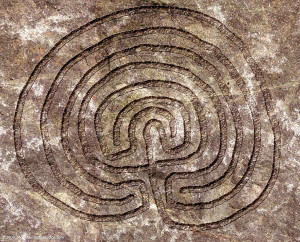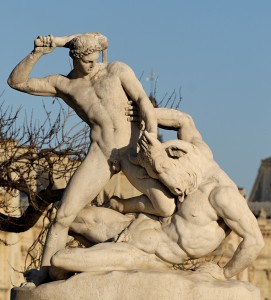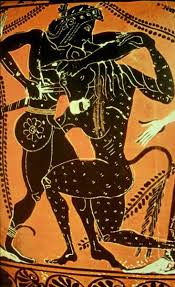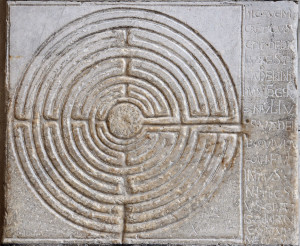Labyrinth or Maze?
From ancient times, labyrinths have been used in sacred rites to symbolize the passageway fro m the visible realm of the human, into the invisible realm of the divine feminine. In modern times, walking the labyrinth is still used as a spiritual ritual. It can also be used as a tool for personal growth and as a method of tapping into the wisdom of our inner knowing to help us live more authentic and purposeful lives. To the uninitiated, however, labyrinth-work can seem off-putting because we often confuse them with the frustration of mazes. This may be due in part to an early introduction to labyrinths through the Greek myth of Theseus and the Minotaur which describes King Minos’ “labyrinth” in terms that are decidedly maze-like. In fact, Theseus has to follow a golden thread given to him by Ariadne in order to find his way back out. Are mazes and labyrinths the same thing? If not, what makes them unique? In exploring the difference between mazes and labyrinths we come to find ways in which they can feel very much the same but result in very different outcomes. And we can begin to appreciate the mysterious way in which the age-old ritual of walking the labyrinth provides us with an opportunity to lose our self in order to find out more truly who we are.
m the visible realm of the human, into the invisible realm of the divine feminine. In modern times, walking the labyrinth is still used as a spiritual ritual. It can also be used as a tool for personal growth and as a method of tapping into the wisdom of our inner knowing to help us live more authentic and purposeful lives. To the uninitiated, however, labyrinth-work can seem off-putting because we often confuse them with the frustration of mazes. This may be due in part to an early introduction to labyrinths through the Greek myth of Theseus and the Minotaur which describes King Minos’ “labyrinth” in terms that are decidedly maze-like. In fact, Theseus has to follow a golden thread given to him by Ariadne in order to find his way back out. Are mazes and labyrinths the same thing? If not, what makes them unique? In exploring the difference between mazes and labyrinths we come to find ways in which they can feel very much the same but result in very different outcomes. And we can begin to appreciate the mysterious way in which the age-old ritual of walking the labyrinth provides us with an opportunity to lose our self in order to find out more truly who we are.
Confusion vs. Clear Path
We know that a maze is designed to be a confusing path which purposefully obfuscates the true route to the finish. Its disorienting false starts and dead-ends are created as a puzzle challenging one to find “the end,” which could be located anywhere in the design; inside or outside its borders. A labyrinth, by contrast, despite its intestine-like twists and turns, is essentially one single path leading to the center. The same path in is followed out. There is no other way to go. Entrance and exit are the same opening. The circuitous path of a labyrinth, with its back and forth movement and sudden veering off in a direction completely opposite to our anticipation, may surprise us, but the actual route itself is never in question.

Ritual Path for Symbolic Rebirth
Ancient people mistook the intestines for the uterus. As such, labyrinths were designed with the intention of creating a ritual path that would lead the initiate back to the womb before a symbolic rebirth. In following the serpentine path of the labyrinth, one becomes disoriented and symbolically “loses his way.” In psychological terms, one becomes released from the confines of his rational, linear thought processes. Arriving at the center, one is able to enter this sacred realm of the feminine in a state of openness where it is possible to receive messages from the unconscious, the divine, the soul’s voice, without judgment. When we understand that it is not an actual physical losing of one’s way but a psychological dissociation from rational thought which is at the core of the ritual labyrinth experience we can forgive the misleading synonymous use of maze and labyrinth in the stories.
back to the womb before a symbolic rebirth. In following the serpentine path of the labyrinth, one becomes disoriented and symbolically “loses his way.” In psychological terms, one becomes released from the confines of his rational, linear thought processes. Arriving at the center, one is able to enter this sacred realm of the feminine in a state of openness where it is possible to receive messages from the unconscious, the divine, the soul’s voice, without judgment. When we understand that it is not an actual physical losing of one’s way but a psychological dissociation from rational thought which is at the core of the ritual labyrinth experience we can forgive the misleading synonymous use of maze and labyrinth in the stories.
Myth as Psychological Metaphor
Let us think about Theseus’ heroic journey into the labyrinth, his slaying of the Minotaur, and safe return using Ariadne’s golden thread as a metaphor for the process of developing psychological awareness. In the story of the myth, Theseus is a young Athenian prince who volunteers to be one of several young men and maidens sent as sacrificial tributes to King Minos of Crete. The youths are forced into an underground labyrinth where they are expected to lose their way and die, or be eaten by the ferocious half-man/half-bull Minotaur who dwells in its center. King Minos’ daughter Ariadne falls in love with Theseus and gives him a ball of golden thread to help him find his way back out. Theseus plunges into the labyrinth with the other youths but he fixes one end of the thread at the entrance to the labyrinth and unrolls it as he proceeds. When he reaches the center, he battles the Minotaur and kills him. Theseus then rescues the remaining youths, and retracing the path shown by Ariadne’s golden thread, he makes his way back to the surface. He escapes King Minos and the isle of Crete, inadvertently leaving the disconsolate Ariadne behind.
King Minos’ daughter Ariadne falls in love with Theseus and gives him a ball of golden thread to help him find his way back out. Theseus plunges into the labyrinth with the other youths but he fixes one end of the thread at the entrance to the labyrinth and unrolls it as he proceeds. When he reaches the center, he battles the Minotaur and kills him. Theseus then rescues the remaining youths, and retracing the path shown by Ariadne’s golden thread, he makes his way back to the surface. He escapes King Minos and the isle of Crete, inadvertently leaving the disconsolate Ariadne behind.
Images as Representation of Psychological Aspects of Self
In very simple psychological terms, we can understand the image of Theseus as representing our ego as well as our masculine, animus energy, or the part of our self which uses rational processes to navigate the outside world. Our ego’s identity can be very much caught up in external values such as status, wealth, and power and how we are seen by others. Ariadne represents the anima, or soul energy of the psyche and those feminine energies in us that connect us to others, to the divine, to that which is greater than our individual ego understanding, to our soul’s  purpose. This constitutes our intuition. Ariadne’s golden thread then, stands for the soul’s knowledge of our intrinsically unfolding Self. This thread can be seen as a great through-line in the psychological development of a person, revealing overall meaning or a sense of purpose to the arc of a life created by individual choices over time. The Minotaur represents fear of the unknown, fear of death, as well as the terrifying animal urges and uncivilized passions which lie under the surface of our humanity and confront us at the core of who we are. The symbol of the labyrinth itself, can be understood from many perspectives and as having many uses. It is a symbol of the psyche and the individuation process, ever moving us towards wholeness. As such is a metaphor for a journey seeking deeper knowledge of the self, and as a metaphor for the overall journey of an individual life. The ritual use of walking the labyrinth can be used as a psychological tool for bringing unconscious material to consciousness, and as a spiritual ritual connecting our ego selves to an awareness of the divine, as mentioned above.
purpose. This constitutes our intuition. Ariadne’s golden thread then, stands for the soul’s knowledge of our intrinsically unfolding Self. This thread can be seen as a great through-line in the psychological development of a person, revealing overall meaning or a sense of purpose to the arc of a life created by individual choices over time. The Minotaur represents fear of the unknown, fear of death, as well as the terrifying animal urges and uncivilized passions which lie under the surface of our humanity and confront us at the core of who we are. The symbol of the labyrinth itself, can be understood from many perspectives and as having many uses. It is a symbol of the psyche and the individuation process, ever moving us towards wholeness. As such is a metaphor for a journey seeking deeper knowledge of the self, and as a metaphor for the overall journey of an individual life. The ritual use of walking the labyrinth can be used as a psychological tool for bringing unconscious material to consciousness, and as a spiritual ritual connecting our ego selves to an awareness of the divine, as mentioned above.
Psychological Interpretation of the Myth
Psychologically speaking, Theseus journeys to the center of the labyrinth to confront death but also, to face the most fearful aspects of his ego self, his own  ferocious animal nature, his rage, sexual appetite, aggression, and selfish desires for power and fame as represented by the Minotaur. Ariadne’s thread provides him with the means of returning to the upper world having done battle with himself in the depths. However, once he has reached the surface and saved his countrymen from the labyrinth, he sets sail for Athens “forgetting” to bring Ariadne with him. This points to a major difficulty in the process of returning to reality from deep introspective psychological or spiritual work. How do we keep the “gold” from our journey holding fast to the wisdom from our inner Self in the harsh demanding light of the everyday world?
ferocious animal nature, his rage, sexual appetite, aggression, and selfish desires for power and fame as represented by the Minotaur. Ariadne’s thread provides him with the means of returning to the upper world having done battle with himself in the depths. However, once he has reached the surface and saved his countrymen from the labyrinth, he sets sail for Athens “forgetting” to bring Ariadne with him. This points to a major difficulty in the process of returning to reality from deep introspective psychological or spiritual work. How do we keep the “gold” from our journey holding fast to the wisdom from our inner Self in the harsh demanding light of the everyday world?
Return Journey Begins Integration Process
There is no return from a maze. The end is the end. Integration of what has been learned is not at issue with a maze. By way of contrast, with a labyrinth, there is most definitely an expectation of return. The center is not the end result. Return to the entrance is the ultimate destination. In ritual work, the return journey from the labyrinth’s center begins the process of integrating the soul’s voice with the ego. The same twists and turns of the labyrinth’s path, in reverse this time, feel familiar, and like a dear old friend serve to remind us of who we are at the core despite the many experiences which may have changed us over time. Each measured step of the return journey helps us gradually re-enter the world of rational thought; allowing us to process and retain the sense of awe and mystery we experienced in the realm of psyche/soul. We return fulfilled and yet humbled. Aware of our profound connection to our deeper selves. Fortified by an inner resolve to remain true to our soul’s purpose. We may lose the thread from time to time, but having taken the journey once, we more readily trust the process and are willing to venture within again and again. As many times as we need in order to feel we are holding true to our inner wisdom and soul’s purpose.

Golden Thread Equals Soul’s Love
This, then is the meaning of Ariadne’s golden thread as it relates to our personal journey into the labyrinthine development of the psyche. In trusting that we are armed with the unfolding energy of our soul’s presence, we have the courage to delve deeply into our unconscious, sometimes with the help of a therapist or spiritual advisor. Although disoriented by life’s unpredictable obstacles, reversals of direction, failures, betrayals, misconceptions, and the like, we are ever supported by love from psyche’s through-line. At times, we may suddenly find our way into a peaceful, centered place where we can distinctly hear our soul’s voice revealing our true connection to the divine and what that means for us. This gives us clarity about our purpose in life and how to proceed with integrity and authenticity in the world. It allows us to make decisions and choices about our lives, careers, and relationships that are grounded in what is truly meaningful to our deeper Self. Our integrative return path to the outer world may be easier felt than seen. However, guided by the shining thread of our soul’s love, with each step we become more fully aware of who we are and who we are meant to be.
©2016 Kathryn Bikle. All Rights Reserved. This article may not be reproduced or used on other websites without permission of the author.
Selected Resources:
Archive for Research in Archetypal Symbolism (ARAS) (2010). The Book of Symbols: Reflections On Archetypal Images. Koln: Taschen.
Artress, L. (1995). Walking a Sacred Path: Rediscovering the Labyrinth as a Spiritual Tool. New York: Riverhead Books, Published by The Berkeley Publishing Group.
Diamond, S. (2009). Why Myths Still Matter: Part Three, Therapy and the Labyrinth. Psychology Today Blog, November 2009. Retrieved 2/10/2016, https://www.psychologytoday.com/blog/evil-deeds/200911/why-myths-still-matter-part-three-therapy-and-the-labyrinth
Diamond, S. (2009). Why Myths Still Matter: Part Four, Facing Your Inner Minotaur and Following Your Ariadnean Thread. Psychology Today Blog, December 2009. Retrieved 2/10/2016, https://www.psychologytoday.com/blog/evil-deeds/200912/why-myths-still-matter-part-four-facing-your-inner-minotaur-and-following
Schaper, D. & Camp, C. (2000). Labyrinths from the Outside In: Walking to Spiritual Insight. Woodstock, VT: SkyLight Paths Publishing.
 (626) 755-6437
(626) 755-6437
